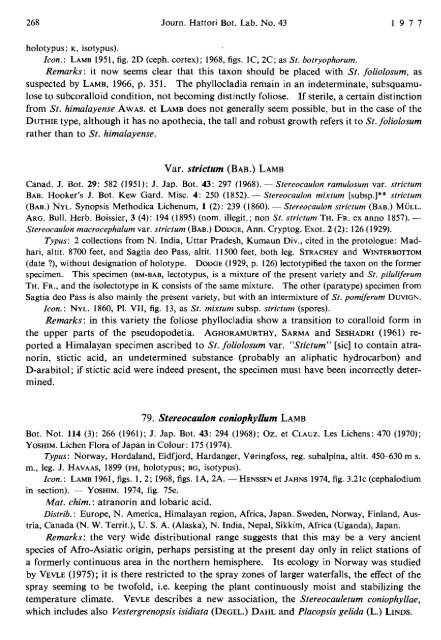A CONSPECTUS OF THE LICHEN GENUS STEREOCAULON ...
A CONSPECTUS OF THE LICHEN GENUS STEREOCAULON ...
A CONSPECTUS OF THE LICHEN GENUS STEREOCAULON ...
Create successful ePaper yourself
Turn your PDF publications into a flip-book with our unique Google optimized e-Paper software.
268 Journ. Hattori Bot. Lab. No. 43<br />
holotypus; K, isotypus).<br />
Icon. : LAMB 1951, fig. 2D (ceph. cortex); 1968, figs. IC, 2C; as St. botryophorum.<br />
Remarks: it now seems clear that this taxon should be placed with St. foliolosum, as<br />
suspected by LAMB, 1966, p. 351. The phyllocladia remain in an indeterminate, subsquamulose<br />
to subcoralloid condition, not becoming distinctly foliose. If sterile, a certain distinction<br />
from St. himalayense AWAS. et LAMB does not generally seem possible, but in the case of the<br />
DUTHIE type, although it has no apothecia, the tall and robust growth refers it to St. jolio~osum<br />
rather than to St. himalayense.<br />
Var. strictum (BAB.) LAMB<br />
Canad. J. Bot. 29: 582 (1951); J. Jap. Bot. 43: 297 (1968). - Stereocaulon ramulosum var. strictum<br />
BAB. Hooker's J. Bot. Kew Gard. Misc. 4: 250 (1852). - Stereocaulon rnixturn [subsp.]** strictum<br />
(BAB.) NYL. Synopsis Methodica Lichenum, 1 (2): 239 (1860). - Stereocaulon strictum (BAB.) MULL.<br />
ARG. Bull. Herb. Boissier, 3 (4): 194 (1895) (nom. illegit.; non St. strictum TH. FR. ex anno 1857). -<br />
Stereocaulon macrocephalum var. strictum (BAB.) DODGE, Ann. Cryptog. Exot. 2 (2): 126 (1929).<br />
Typus: 2 collections from N. India, Uttar Pradesh, Kurnaun Div., cited in the protologue: Madhari,<br />
altit. 8700 feet, and Sagtia deo Pass, altit. 11500 feet, both leg. STRACHEY and WINTERBOTTOM<br />
(date ?), without designation of holotype. DODGE (1929, p. 126) lectotypified the taxon on the former<br />
specimen. This specimen (EM-BAB, lectotypus, is a mixture of the present variety and St. piluliferum<br />
TH. FR., and the isolectotype in K consists of the same mixture. The other (paratype) specimen from<br />
Sagtia deo Pass is also mainly the present variety, but with an intermixture of St. pomiferurn DuVIGN.<br />
Icon.: NYL. 1860, PI. VII, fig. 13, as St. mixtum subsp. strictrim (spores).<br />
Remarks: in this variety the foliose phyllocladia show a transition to coralloid form in<br />
the upper parts of the pseudopodetia. AGHORAMURTHY, SARMA and SESHADRI (1961) reported<br />
a Himalayan specimen ascribed to St. foliolosum var. "Stictum" [sic] to contain atranorin,<br />
stictic acid, an undetermined substance (probably an aliphatic hydrocarbon) and<br />
D-arabitol; if stictic acid were indeed present, the specimen must have been incorrectly determined.<br />
79. Stereocaulon coniophyllum LAMB<br />
Bot. Not. 114 (3): 266 (1961); J. Jap. Bot. 43: 294 (1968); Oz. et CLAUZ. Les Lichens: 470 (1970);<br />
YOSHIM. Lichen Flora of Japan in Colour: 175 (1974).<br />
Typus: Norway, Hordaland, Eidfjord, Hardanger, Veringfoss, reg. subalpina, altit. 450-630 m s.<br />
m., leg. J. HAVAAS, 1899 (FH, holotypus; BG, isotypus).<br />
Icon.: LAMB 1961, figs. 1, 2; 1968, figs. lA, 2A. - HENSSEN et JAHNS 1974, fig. 3.21~ (cephalodium<br />
in section). - YOSHIM. 1974, fig. 75e.<br />
Mat. chim. : atranorin and lobaric acid.<br />
Distrib. : Europe, N. America, Himalayan region, Africa, Japan. Sweden, Norway, Finland, Austria,<br />
Canada (N. W. Territ.), U. S. A. (Alaska), N. India, Nepal, Sikkim, Africa (Uganda), Japan.<br />
Remarks: the very wide distributional range suggests that this may be a very ancient<br />
species of Afro-Asiatic origin, perhaps persisting at the present day only in relict stations of<br />
a formerly continuous area in the northern hemisphere. Its ecology in Norway was studied<br />
by VEVLE (1975); it is there restricted to the spray zones of larger waterfalls, the effect of the<br />
spray seeming to be twofold, i.e. keeping the plant continuously moist and stabilizing the<br />
temperature climate. VEVLE describes a new association, the Stereocauletum coniophyllae,<br />
which includes also Vestergrenopsis isidiata (DEGEL.) DAHL and Placopsis gelida (L.) LINDS.

















